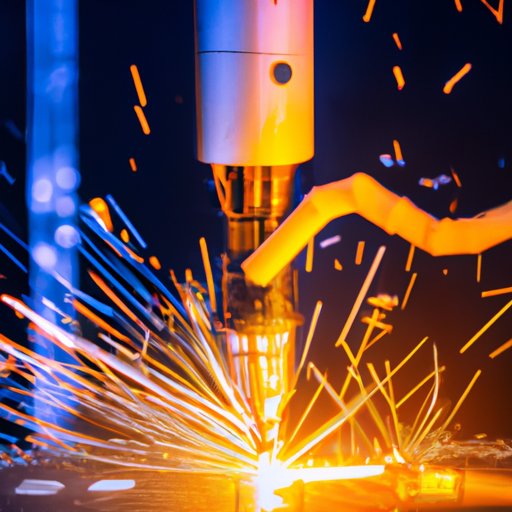Introduction
Robotic welding is an automated manufacturing process that uses robots to weld metal components together. It has become increasingly popular in recent years as it offers many advantages over manual welding, such as increased speed, precision, and accuracy. Robotic welding is used in a variety of industries, including automotive, aerospace, and medical. In this article, we will explore what robotic welding is, its benefits and limitations, and how it is being used in different industries.
The Basics of Robotic Welding and Its Benefits
Robotic welding involves the use of robots to automate the welding process. The robot is programmed with a specific set of instructions, which it follows to weld the metal components together. The process is highly accurate and efficient, allowing manufacturers to produce higher quality products in less time. Additionally, it eliminates the need for manual labor, which can be dangerous and expensive.
Robotic welding offers several advantages over traditional welding methods. For one, it can be completed faster and with greater precision than manual welding. Additionally, it reduces the risk of human error, which can result in costly mistakes and product defects. Furthermore, robotic welding is more cost-effective than manual welding, as it requires fewer resources and less labor.
Robotic welding is typically done using two processes: arc welding and spot welding. Arc welding uses an electric arc to join two pieces of metal together and is commonly used in the automotive and aerospace industries. Spot welding uses an electrical current to create a strong bond between two pieces of metal and is often used in the medical industry.

A Look at Robotic Welding in Different Industries
Robotic welding is becoming increasingly popular in a variety of industries. In the automotive industry, robotic welding is used to assemble car bodies, frames, and other parts. It allows manufacturers to produce cars quickly and efficiently, while also ensuring a high level of quality. In the aerospace industry, robotic welding is used to assemble aircraft components, such as wings and fuselages. Finally, in the medical industry, robotic welding is used to construct implants, prosthetics, and artificial organs.
What Are the Challenges of Implementing Robotic Welding?
Despite the many advantages of robotic welding, there are some challenges associated with its implementation. One of the main challenges is cost. Robotic welding systems can be expensive to purchase and maintain, which can make them cost-prohibitive for some manufacturers. Additionally, there are safety concerns associated with robotic welding, as the robots must be properly programmed and monitored to prevent injuries or accidents. Finally, robotic welding systems can be difficult to program, which can limit their effectiveness.

Understanding the Benefits and Limitations of Robotic Welding
Robotic welding can provide a number of benefits to manufacturers, such as increased efficiency, improved quality, and increased reliability. According to a study by the American Welding Society, robotic welding can increase productivity by up to 20%, while reducing costs by up to 25%. Additionally, robotic welding can improve the accuracy and consistency of welds, resulting in higher quality products. Finally, robotic welding can reduce the risk of errors and defects, resulting in more reliable products.
However, there are also some limitations to robotic welding. Since robotic welding is highly automated, it relies heavily on programming, which can be difficult to do correctly. Additionally, robotic welding systems require regular maintenance and upkeep, which can be costly and time-consuming. Finally, robotic welding systems may not be suitable for all applications, such as those requiring intricate detail or complex shapes.
Conclusion
Robotic welding is an automated manufacturing process that has revolutionized industrial production. It offers many advantages over traditional welding methods, such as increased speed, precision, and accuracy. Additionally, it can reduce costs and eliminate the need for manual labor. Robotic welding is being used in a variety of industries, including automotive, aerospace, and medical. However, there are some challenges associated with implementing robotic welding, such as cost, safety, and programmability. Despite these challenges, robotic welding can provide manufacturers with increased efficiency, improved quality, and increased reliability.
(Note: Is this article not meeting your expectations? Do you have knowledge or insights to share? Unlock new opportunities and expand your reach by joining our authors team. Click Registration to join us and share your expertise with our readers.)
